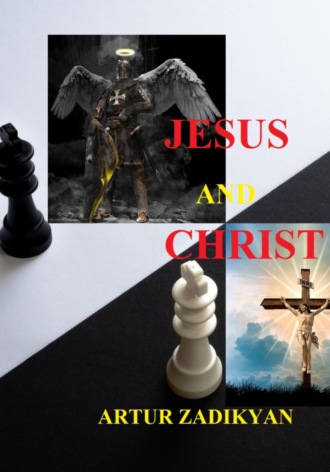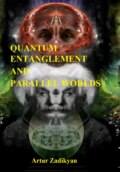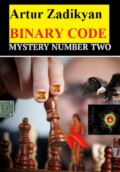
Artur Zadikyan
Jesus and Christ
The theologian was silent for a moment.
– In general, I would not like to emphasize the opinion about faith and unbelief, but I will note that both atheists and people who are more inclined to seek a scientific explanation for everything that happens, including history, have the right to their opinion. For some reason, no one considers it an offense to atheists' belief that there is no God to assert that God exists. After all, atheists believe they are right too. It may seem strange to hear me, a representative of the church, say this, but it is the lack of entitlement of atheists to be equal to those who believe in God that speaks to the fear of their faith. Okay, let's not talk about arguments, although the whole story and its subsequent application is based on an argument. After all, disputes exist within Christian denominations as well. What to speak of different faiths among themselves. For me, all these disputes give birth to the truth or at least give an alternative point of view on the statements taken as a basis. And all the more from the scientific side they open the picture of the world in different perspectives, including its mythological hypostasis. Here, for example, is an interesting one. The usual symbol for the four Gospels is the mysterious chariot seen by the prophet Ezekiel at the river Hovar, which consisted of four creatures that resembled a man, a lion, a calf and an eagle. These creatures, taken individually, became emblems for the evangelists. Christian art since the 5th century depicts Matthew with a man or angel, Mark with a lion, Luke with a calf, John with an eagle. Of the four Gospels, the content of the first three – Matthew, Mark, and Luke – is much the same. They are called synoptic, from the Greek word "synopsis," which means "an account in one general pattern." The Synoptic Gospels tell mainly about the activities of the Lord Jesus Christ in Galilee, while the Evangelist John tells of them in Judea. The Synoptics write nothing about Jesus' life in the early years. Nothing about his life in Judea or Jerusalem. Although we can understand from their narrative that he had supporters and friends there. For example, the owner of the upper room where the Last Supper took place and Joseph of Arimathea. The main difference between the Synoptics and the Evangelist John lies in the conversations of the Lord. With the Synoptics these conversations are very simple, easy to understand; with the Evangelist John, they are deep, mysterious, and often difficult to understand. The Synoptics bring out the more human side of Christ, while John mostly brings out the divine side. To better interpret and understand the Gospels, we need to become more familiar with the personality, character, and life of each of the four evangelists and the circumstances under which each of the four Gospels was written.
The scientist took a few moments to catch his breath and began to speak with renewed vigor:
– Let's begin with the Gospel of Matthew. Matthew was one of the 12 apostles of Christ. The evangelists Mark and Luke call him Levi. It was the custom of the Jews to have several names. Before his call to apostolic ministry, he was a tax collector, and as such was certainly disliked by his fellow Jews, and especially by the spiritual leaders of the Jewish people, the scribes and Pharisees. However, having received the favor of Christ, having seen in him the possibility of repentance and change of his essence, he became his devoted follower and especially took to heart the cause of salvation of his native Jewish people, so saturated by that time with false notions and Pharisaic views. Therefore, his Gospel is considered to have been written primarily for the Jews. In his presentation, Matthew's main goal is to prove to them that Jesus Christ is the Messiah spoken of by the prophets of the Old Testament; that the Old Testament revelation, which had been obscured by the scribes and Pharisees, is clarified and given its perfect meaning only in Christianity. Here I must make it clear: the Jews themselves, the adherents of the Jewish religion, do not in any way take Christ for the Messiah, or even for a prophet. Matthew preached in Palestine for a long time. Then he went to other countries to preach, and ended his life as a martyr in Ethiopia.
Ffitnop habitually looked around the audience and announced:
– Let's turn to the Gospel of Mark. Many people believe that all the authors of the Gospels are apostles of Christ. But this is not the case. Mark, for example, was not one of the twelve apostles. By the way, this is an important indicator that makes us doubt the full reality of all the stories given to the world from the evangelists. For some reason, the Gospels from the apostles themselves, those who were directly involved, are hidden. Or are off-limits for public perusal. But Mark was not a constant companion and listener of the Lord, as, for example, Matthew was. He wrote his Gospel with the words and under the guidance of the apostle Peter. By the way, Mark also bore the name of John. By the way, in this regard, pay attention to the revolutionary nicknames of Lenin's associates and in general, ask about their real surnames, and their first names and patronymics too. All right, let's not get distracted. I'll tell you about it sometime later.
The scientist smiled enigmatically.
– Mark accompanied the apostle Paul on his first journey, along with another companion, Barnabas, to whom he was either a nephew or a cousin. According to tradition, the Apostle Peter made Mark the first bishop of the Church of Alexandria. There Mark was martyred, I would say killed. As I said, Mark wrote his Gospel from the words of the Apostle Peter. It says very little about the relationship of the teachings of the Lord Jesus Christ to the Old Testament and makes very few references to Old Testament holy books. For some reason he does not even write about the Sermon on the Mount. But in his Gospel he wrote inspiringly about the miracles of Christ. The miracles he allegedly performed, or maybe not even allegedly. But here I must remind those who know, or explain to those who do not know – miracles are forbidden in Christianity. Remember the fires of the Inquisition. And in general, there is such a cool technique, it is aimed at preventing the appearance of the messiah not by the will and not under the control of those who control the church, and through it the believers. So, this is such a tricky trick, which says: when the messiah comes, as if the Second Coming will be accomplished, before that there must be the Antichrist, he will proclaim himself the messiah, and those who are waiting, almost all of them, will accept him. And one of the reasons why he will be accepted will be the performance of miracles. And it is a cunning move, because always a "stranger", that is not from the clan of his confession, can be called a false messiah, even if he complies with all the canons. And in this tactical move, anyone can be called an antichrist, even if he conforms to the doctrine of the second coming. First recognized, and then, if out of control, branded the devil and Satan. At worst, a sorcerer. This technique is another component in the complex formula of the divine definition of creation. And Mark has made a very important contribution there. In his Gospel Jesus is already presented as a deity. If Matthew still perceives him as a "son of David", because, according to tradition, the Messiah, i.e. the savior, must be from this family, Mark calls him the Son of God, the Lord and Master, the King of the Universe.
This was followed by another scanning gaze of the listeners in the best traditions of the gendarmes of the Inquisition. It seemed that Nomor saw something else behind the holographic images of experts, penetrated through their virtual gaze into real souls. Apparently satisfied, he exhaled. The effect created by the muffled sound had a strange, slightly unpleasant, but magical impression, as if the scientist held something inside him that hypnotized the audience.
– Next is the Gospel of Luke," said the servant of God with a smile. – What can be said about him? B was a physician as well as a painter. His Gospel contains Jesus' instructions to the 70 disciples in great detail, which is a logical indication that he belonged to them. By the way, many are convinced that there were only 12 supporters of Christ. In fact, there were many more. Luke often accompanied the apostle Paul in his travels, and after his death he preached, then took martyrdom in Achaia. His holy relics were transferred to Constantinople in the 4th century along with the relics of the Apostle Andrew. Luke wrote his Gospel at the request of a nobleman, Theophilus, who lived in Antioch. That's modern-day Antalya, by the way. What is interesting is that he used not only oral recollections of Christ from people who knew the story of Jesus, but also pre-existing records of him. It is difficult to determine when he wrote his gospel. There are different estimates. Some scholars date it hundreds of years after the events described. He himself writes of his painstaking analysis of existing records and oral traditions about Christ. In addition, he wrote his Gospel as if to order, at the request of Theophilus, who, by the way, did not live in Judea and did not visit Jerusalem, because Luke makes various geographical explanations about this area. But on such points as Syracuse, Rigia, Puteol in Italy, Appian Square and three inns in Rome, the evangelist Luke makes no explanations at all. It is logical to assume the client knew these places. According to Clement of Alexandria, who lived at the beginning of the third century, Theophilus was a rich and noble resident of Antioch, he was most likely the head of the local Christian sect. In his house he set up a temple for the Antioch Christians. Paul's ideology and worldview is evident in his Gospel. This is expressed, among other things, in the emphasis on the idea that the Messiah came to earth not only for the Jews, but for the whole world, all people. He traces the genealogy of Jesus from Adam, the ancestor of all mankind, to God in order to emphasize his importance for the whole world. He reveals such an idea in such events as the healing of Nehemiah the Syrian from leprosy by the prophet Elisha, the parables of the Prodigal Son and the Publican and the Pharisee. In the description of these events there is a clear stylistics of the apostle Paul's teaching about the salvation not only of the Jews, but also of the Gentiles, and about the justification of man before God not by the works of the law, but by the grace of God. He portrayed the love of God for repentant sinners very vividly, and gives in his gospel many parables and actual events on this subject. For example, the parables of the lost sheep, the lost drachma, the merciful Samaritan, and the story of the repentance of the chief of the tax collectors named Zacchaeus. Significant words about "that so in heaven there will be more joy in one sinner repenting than in ninety-nine righteous men who have no need of repentance." The Gospel of Luke was most likely written in Rome. This again shows that Rome, as the power in the region, used the proclaimed teachings of Christ for ideological processing to control and subdue more and more plebeians. You hopefully know who the patricians and plebeians are.
Without waiting for a reaction from his listeners other than lazy smiles, the theology professor continued:
– Let's move on to the Gospel of John. The evangelist John, later called the Theologian, was one of Christ's favorite, and perhaps the most beloved, disciples. His father was a fisherman, but most likely not a simple one. This is evidenced by the presence of employees, which at that time was considered a fact of wealth. In addition, his father had a solid position in society, for his son John was acquainted with the high priest. His mother, Solomia, is mentioned among the wives who served the Lord with their property. What does it mean? This is another proof of my interpretation that this whole story is not a simple altruistic impulse of the soul, asking people to be kinder, not to kill, not to steal, etc., but a struggle of political forces. Accordingly, there were supporters, and the financial component played a significant role. Solomia, by the way, followed Jesus to Jerusalem for the last Passover and participated in the purchase of aromas for anointing his body together with other Myrrh-bearing wives. There is a very interesting fact here. Tradition considers her to be the daughter of Joseph the Betrothed. And who is Joseph the Handmaiden? Yes, yes, someone may be surprised, but this is the same Joseph to whom Mary was married, who, as we know, let me say biblically, had in her womb. John learned about Christ by being a disciple of John the Baptist. Don't confuse the two, please. Many do. Then, after an almost magical catch of fish on the Lake of Galilee, Jesus himself called him, along with his brother James, to join his ranks. Together with Peter and his brother James, he was by Christ's side at the most important events. For example, he was present at the raising of Jairus' daughter, saw the transfiguration of the Lord on the mountain, heard the conversation about the signs of his Second Coming, and witnessed his Gethsemane prayer. Here again I am going a little bit away from the main line. And I apologize right away. You probably realized that I want to voice my version, my vision. I have already said that we must remain cold empiricists, even if we believe in Christ, we must always ask ourselves the question – how is it possible? Exactly what is written about in the Gospels. It is easy to say "God did this magic because he is God", but not everyone can understand how it really happened. And I also want to speak about the so-called holy lie. When a lie is given for salvation. So, in my interpretation of everything that happened in this story there is a holy lie, or a lie for salvation. You may have realized, I don't believe in miracles and all these miraculous events. That is, for me, Jesus was conceived as a man, resurrected spiritually – in people's minds, all these miracles are a religious interpretation of events, a theological interpretation, a lie for salvation. The salvation of people who don't believe in such things. If, of course, they need such salvation. The bottom line: only the desire to realize it in reality, the belief in it, will lead mankind to the real realization of everything.
The theologian looked at his listeners appraisingly.
– Now let's get on with the subject. He received the nickname "thimble", which later became a nickname, because he was very close to Christ at the Last Supper. This closeness was also manifested when Jesus, being nailed to the cross, entrusted his mother to him, saying to him, "Behold your mother!" John the Theologian's mother was the daughter of Joseph the Handmaiden, she was Jesus' sister by his father (stepfather) and John was his nephew. Joseph was of advanced age at the time of his marriage to Mary, and she was about 14-15 years old at the time of her marriage, which gives estimates of the ages of both John and his mother. Joseph married his daughter off to his brother (such were the mores of the time) after returning from escaping to Egypt. John was not much younger than Christ. John was very angry when anyone judged Christ or expressed doubts. He even asked his permission to rain fire on a Samaritan village because they did not accept him. Here I ask you to pay attention to such a thing. You don't believe in the commandment "thou shalt not kill", then you can and should be killed. That's my black humor. It kind of comes out that way, don't you agree? Subsequently, the place of John's life and activity is the city of Ephesus in Asia Minor. In the reign of Emperor Domitian he was sent into exile on the island of Patmos, where he wrote the Apocalypse. When he returned from this exile to Ephesus, he wrote his Gospel there and died his death, the only one of the apostles, at a profound old age, almost 105 years old. Although his death, according to tradition, was mysterious. John wrote his Gospel at the request of the Ephesian Christians. They brought him the first three Gospels and asked him to complete them. By the way, here too is an interesting point, it is strange that he was not familiar with these writings and they did not agree with him on their vision and interpretations of the life and teachings of Christ. Having familiarized himself with the written Gospels, he found in them a realistic account of events, but being very close to Christ, knowing the secret doctrine, he found it necessary to add to their narrative the doctrine of the divine hypostasis of Jesus Christ. He explained it, – or, perhaps, later churchmen put it in such a way, so that people in the course of time would not think of him only as the son of man. There's another point to decipher here. Stories about the divine conception, about the son of God, about miracles performed were well known in the ancient world. To expound them, to confirm their authenticity and to "guide" the belief in such a miracle was the exclusive right of the Holiness, who governed the souls and thoughts of men. Therefore, to take the role of gods, to convince the flock of their divinity was a blasphemous deed. Just as it is now. So, at first, all these stories connected with Christ were perceived by those in authority and the people with doubt. The more seriously the people were persuaded, the more the power class became involved, the more angry and irritated they became. And after they, the followers of Christ, declared his resurrection and began to convince the people of it – the fury was unbelievable. Accordingly, refutations began to appear. Moreover, people did not lack logic. The point is that the diversity of gods in the ancient world was also considerable. But the trick of the followers of Christ was in the proclamation of the super-god, the most important, the most important for all. It was almost an insult to the power caste and nobility, and in fact it was, an insult to the elite. After all, it was God who allowed them to rule, gave them people to serve. And here someone declares that all are equal before God. In general, John realized the dangerous tendency in time and in his Gospel he made Jesus God. The opposite front, realizing that the power could go, so to speak, to the masses, saw the danger for itself and strengthened the policy of refutation. Speaking in church language, so-called heresies began to appear, denying the divinity of Christ – Evionites and Gnostics. In the Gospel of John there are even testimonies of Jesus about himself as the son of God. This, too, is an important aspect to uncover the politics of the confrontation. How to put it in a softer way. For example, someone will say: I am the son of God, I was sent to the earth to save you. I think you get my point. You can say whatever you want, that you are popular, loved by everyone, talented, worthy of Nobel and other prizes, that you are from God and so on, but as long as you are not recognized as such by the society, you will not be such. That is, in the case of Christ, he most likely did not say such things about himself. Moreover, it is not found in other testimonies and previous Gospels before John. With the Gospel of John begins the story in which man, the son of man, struggling for the freedom of people, for the understanding of their common brother-sisterhood, for the understanding of some common divine substance of humanity, turns into a magical deity. That is, into the one with whom Jesus himself fought. This is such a paradox… An important feature of John's Gospel is also the fact that while the first three evangelists narrate mainly the preaching of Jesus Christ in Galilee, John recounts the events and speeches that took place in Judea. With this we can calculate the length of Christ's public ministry and at the same time the length of his earthly life. Jesus preached more in Galilee, and traveled to Jerusalem for all the major feasts. According to the Gospel of John, there were only three such journeys to Jerusalem for the Feast of Passover, and before the fourth Passover of his public ministry he died on the Cross. It follows that the Lord's public ministry lasted about three and a half years. As Luke testifies, Jesus went out into public ministry about 30 years of age. This means that he lived on earth for only thirty-three and a half years.
The professor thought for a moment.
– Now let's look at the perception of the gospel and biblical stories from different angles by supporters and opponents, that is, believers and, so to speak, not really. Those who are "not quite" consider the following to be the main proof of their doctrine: Christians invented the virgin conception of Jesus to emphasize the importance of his person. This is their central myth. All the evangelists write about Jesus' birth from Mary, her conception without an earthly father. Let's see how it is described in the Gospels, for example, in Matthew; the nativity of Jesus Christ was like this: "after the betrothal of his mother Mary to Joseph, before they were joined together, it appeared that she had in her womb of the Holy Spirit. But Joseph, her husband, being righteous and not wanting to make her public, wanted to let her go in secret. But when he thought of it, behold, an angel of the Lord appeared to him in a dream and said, "Joseph, son of David, do not be afraid to take Mary your wife, for that which is born in her is of the Holy Spirit; but she will bear a Son, and you shall call His name Jesus, for He will save His people from their sins" (Matthew 1:18-21). And here is what Evangelist Luke says: "In the sixth month the angel Gabriel was sent from God to the city of Galilee, called Nazareth, to a virgin betrothed to a man named Joseph, of the house of David; and the name of the virgin was Mary. The angel came to her and said, "Rejoice, O Most Gracious One! The Lord is with thee; blessed art thou among women. But when she saw him, she was troubled at his words and wondered what kind of greeting it would be. And the angel said to her, "Do not be afraid, Mary, for you have found grace with God; and behold, you will conceive in the womb and bear a Son, and you will call His name Jesus… Mary said to the angel, "How will this be, when I do not know my husband?" (Luke 1:26-35)
The theologian was meaningfully silent.
– Please pay attention here and draw conclusions. First of all, in the first case she knows about her pregnancy… or at least Joseph knows from somewhere. If we take her ignorance as truth, then it is absurd. The next conclusion is that the Gospels were written at different times, with a disregard for accuracy, sloppiness in the approach to the work, or incompetence on the part of the scribes. Why? Here's why. Look at the dialog between Mary and the Angel. Based on it, Mary did not know she was pregnant. But in Matthew's story, she did. At least she should have known, and not just her. Otherwise, how did Joseph know? Or, if we take such a version, she grew a belly before time, Joseph, having realized the essence, was indignant, then for her it should not have been news for sure. And also – look at Luke's description: in fact, she is not pregnant yet, based on the angel's warning, "…and behold, you will conceive (!!!) in the womb…". This is just an example of how the story is told. Let's not cling to words. For, let me also explain myself in the rhetoric of those who use expressions accepted in the parochial canon. You will agree that if you analyze the biblical accounts with an open mind, the whole rhetoric of those who are committed to the truth of the biblical events and those who are against, i.e. do not believe or doubt, is built on this kind of argument and arguments. I have already said, here it is written this and that. And here it says this and that, and from this follows this and that. Is it funny? Me too. But to me it is because of the argument, in which the criterion of truth and untruth is not a fact, but someone's presentation of some history. You understand correctly, even if many sources will write about some historical object, for example, about sword escalibur, that it belonged to the person, which according to chronicles exactly existed, – it will not be a fact concerning this weapon, especially in the aspect of modern beliefs, if radiocarbon analysis will show, will prove its manufacturing later than the attributed events. But if around a certain history there will be a lot of various tales, and with a philosophical and instructive bias, and also serve to attract adherents, plus to everything – if with the coincidence of time there will be opponents and refuting, and even alternative histories, in this case, firstly, it will be forgotten and few people will wonder whether it happened at all, and secondly, different combinations of statements will be interpreted in their own way in order to prove their rightness, and in some cases, for example, biblical, their holiness. After all, disputes to prove, as it were, the improvement of a religious doctrine, exactly the type of this doctrine (as disputes can take place within one confession), are conducted with the purpose to prove the best, let me put it this way, the holiness, divinity of one's religion, confession, sect. The disputes about the Immaculate Conception follow the same scenario. Some rely on faith and spirituality, others on logic and realism. For example, realists believe that it is a myth created by Christians to emphasize the importance of Jesus. Incidentally, realists may well be Christians themselves. For example, Protestant theologian Harry Emerson Fosdick put it this way: "Belief in the immaculate birth as an explanation for the identity of a great man is a well-known way in which extraordinary exceptionalism was explained in antiquity." I have already described numerous examples in myths and legends.
Nomor stopped his narration, stopped "marching" along the route he had set, looked thoughtfully at those to whom his speech was dedicated. He summarized:
– Let's have a little smile.
The audience supported his call. After receiving the energy charge, he continued:
– It is quite logical that Christians, wanting to win over the pagan audience, presented them with the virgin conception of Jesus, because such a thing was in the practice of deification. It had happened more than once. This was another rebuke to Jesus, the desire of the Jewish clergy to destroy him and his sect. However, he and his company knew what they were doing. They understood: to win, to assert their power over the souls and minds of people, they needed to consistently and firmly assert their postulates, to attract slaves, those who had nothing to lose, as Vladimir Ilyich said, "nothing but their chains. So that it would have the effect of sacrifice for salvation. That is, they were already oppressed, so the affirmation of their faith gave them an invisible weapon, power, which they were deprived of in the material world… moreover, according to their faith it turned out that after death they would live in some divine kingdom. This infuriated those in power. This consistency, despite oppression and oppressions, led not just to a belief in the Immaculate Conception – to a subconscious doubt that such a thing was impossible. Even people with the logic of empirical thinking began to speculate about the reality of it, even if invested with the thought of a highly developed civilization, which in this way tries to tune mankind to the desired manner and policy of behavior.
Nomor took a heavy breath, sipped some water. Pluto took advantage of the pause.
– What was it really like? Your personal version.
– You may laugh, but I'll tell you, a century to learn…" he smiled and added: "I'll even say, now it's possible, an eternity to learn and…" he smiled again.
His smile infected many experts in the audience, though not all of them. Some, on the contrary, became more serious, even glanced ironically at their colleagues in the program. Nomor, noticing this, explained his opinion:
– In connection with the discovery of the method of traveling between worlds… and the worlds themselves, and the worlds being in different time chronology in relation to the development of human society on our planet… we can check how it was and is there. So I will answer the question: if I believe in miracles, it is only in that scientific conception, which speaks about not yet revealed this phenomenon by the level of science. The other side of this logic is unconditional faith. That is faith without conditions. And without conditions one can believe in anything. Logically, I believe in rationality and reality. And most importantly, as one very wise saint said, God does not perform miracles for the amusement of people. By the way, this is how he revealed himself about the extraction of the gracious fire from an ordinary lighter, with which he lit candles in the Kuvukliya6 .
– Oh! – Venus exclaimed, as if this revelation were her own personal tragedy.
Apparently determined to finish her off, Nomor added:
– Very often the Immaculate Conception is used in arguments in terms of proving the contrary. In fact, it played into the hands of Christians to attract like-minded people. Allegedly, the followers of Christ had to speak about his real conception from a man, because a pregnant girl not from her husband, and from whom it is unknown, was a disgrace. But here they omit the fact, and I frankly think they are lying, that conception by the Holy Spirit was a cult and privilege of gods or divine persons. Here I must make a footnote – see the beginning of the lecture. Although I would feel more comfortable saying – stories. It's not like we're listening to all this for an exam.







